
The Golden Horde, self-designated as Ulug Ulus, lit. 'Great State' in Turkic, was originally a Mongol and later Turkicized khanate established in the 13th century and originating as the northwestern sector of the Mongol Empire. With the fragmentation of the Mongol Empire after 1259 it became a functionally separate khanate. It is also known as the Kipchak Khanate or as the Ulus of Jochi, and replaced the earlier less organized Cuman–Kipchak confederation.

Khan is a historic Turkic title originating among nomadic tribes in the Central and Eastern Eurasian Steppe to refer to a chief or ruler. It first appears among the Rouran and then the Göktürks as a variant of khagan and implied a subordinate ruler. In the Seljuk Empire, it was the highest noble title, ranking above malik (king) and emir (prince). In the Mongol Empire it signified the ruler of a horde (ulus), while the ruler of all the Mongols was the khagan or great khan. The title subsequently declined in importance. In Safavid dynasty it was the title of an army general, and in Mughal India it was a high noble rank restricted to courtiers. After the downfall of the Mughals it was used promiscuously and became a surname. Khan and its female forms occur in many personal names, generally without any nobiliary of political relevance, although it remains a common part of noble names as well.
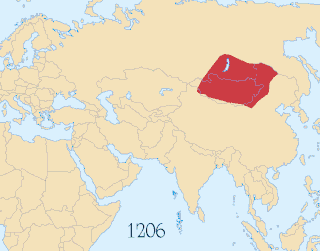
The Mongol Empire of the 13th and 14th centuries was the largest contiguous land empire in history. Originating in present-day Mongolia in East Asia, the Mongol Empire at its height stretched from the Sea of Japan to parts of Eastern Europe, extending northward into parts of the Arctic; eastward and southward into parts of the Indian subcontinent, attempted invasions of Southeast Asia and conquered the Iranian Plateau; and westward as far as the Levant and the Carpathian Mountains.
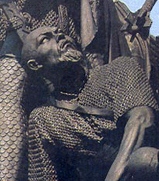
Mamai was a powerful military commander of the Golden Horde. Contrary to popular misconception, he was not a khan (king), but a warlord and a kingmaker for several khans, and dominated parts or all of the Golden Horde for a period of almost two decades in the 1360s and 1370s. Although he was unable to stabilize central authority during a period of civil war, Mamai remained a remarkable and persistent leader for decades, while others came and went in rapid succession. His defeat in Battle of Kulikovo marked the beginning of the decline of the Horde, as well as his own rapid downfall.

Tolui was a Mongol khan, the fourth son of Genghis Khan by his chief khatun, Börte. At his father's death in 1227, his ulus, or territorial inheritance, was the Mongol homelands on the Mongolian Plateau, and he also served as civil administrator until 1229, the time it took to confirm Ögedei as the second Great Khan of the Mongol Empire (1206–1368). Before that, he had served with distinction in the campaigns against the Jin dynasty, the Western Xia and the Khwarezmid Empire, where he was instrumental in the capture and massacre at Merv and Nishapur. He is a direct ancestor of most of the Ilkhanids.

Jochi Khan was a Mongol army commander who was the eldest son of Temüjin, and presumably one of the four sons by his principal wife Börte, though issues concerning his paternity followed him throughout his life. An accomplished military leader, he participated in his father's conquest of Central Asia, along with his brothers and uncles.

Sultan Giyas al-Din Mohammed Öz Beg, better known as Uzbeg, Uzbek or Ozbeg (1282–1341), was the longest-reigning khan of the Golden Horde (1313–1341), under whose rule the state reached its zenith. He was succeeded by his son Tini Beg. He was the son of Toghrilcha and grandson of Mengu-Timur, who had been khan of the Golden Horde from 1267 to 1280. Hence, he was a direct descendant of Genghis Khan.

The Lipka Tatars are a Turkic ethnic group who originally settled in the Grand Duchy of Lithuania at the beginning of the 14th century. The first Tatar settlers tried to preserve their shamanistic religion and sought asylum amongst the non-Christian Lithuanians. Towards the end of the 14th century, another wave of Tatars – this time, Muslims, were invited into the Grand Duchy by Vytautas the Great. These Tatars first settled in Lithuania proper around Vilnius, Trakai, Hrodna and Kaunas and later spread to other parts of the Grand Duchy that later became part of Polish–Lithuanian Commonwealth. These areas comprise parts of present-day Lithuania, Belarus and Poland. From the very beginning of their settlement in Lithuania they were known as the Lipka Tatars. While maintaining their religion, they united their fate with that of the mainly Christian Polish–Lithuanian Commonwealth. From the Battle of Grunwald onwards the Lipka Tatar light cavalry regiments participated in every significant military campaign of Lithuania and Poland.
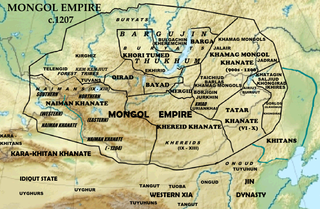
A Borjigin is a member of the Mongol sub-clan, which started with Bodonchar Munkhag of the Kiyat clan. Yesugei's descendants were thus said to be Kiyat-Borjigin. The senior Borjigids provided ruling princes for Mongolia and Inner Mongolia until the 20th century. The clan formed the ruling class among the Mongols and some other peoples of Central Asia and Eastern Europe. Today, the Borjigid are found in most of Mongolia, Inner Mongolia and Xinjiang, and additionally genetic research has shown that descent from Genghis Khan and Amir Timur Barlas is common throughout Central Asia and other regions.

The Naiman were a medieval tribe originating in the territory of modern Western Mongolia, and are one of the tribes of modern Mongols and in the middle juz of the Kazakh nation.

Toghrul, also known as Wang Khan or Ong Khan was a khan of the Keraites. He was the blood brother (anda) of the Mongol chief Yesugei and served as an important early patron and ally to Yesugei's son Temüjin, later known as Genghis Khan. The main source on his life is The Secret History of Mongols.

The Ongud were a Turkic tribe that later became Mongolized active in what is now Inner Mongolia in northern China around the time of Genghis Khan (1162–1227). Many Ongud were members of the Church of the East. They lived in an area lining the Great Wall in the northern part of the Ordos Plateau and territories to the northeast of it. They appear to have had two capitals, a northern one at the ruin known as Olon Süme and another a bit to the south at a place called Koshang or Dongsheng. They acted as wardens of the marches for the Jin dynasty (1115–1234) to the north of Shanxi.
The Mangghud, or Manghud, were a Mongol tribe of the Urud-Manghud federation. They established the Nogai Horde in the 14th century and the Manghit dynasty to rule the Emirate of Bukhara in 1785. They took the Islamic title of Emir instead of the title of Khan, since they were not descendants of Genghis Khan and rather based their legitimacy to rule on Islam. The clan name was used for Mongol vanguards as well. Their descendants live in several regions of the former Mongol Empire.
A khaganate or khanate was a polity ruled by a khan, khagan, khatun, or khanum. That political territory was typically found on the Eurasian Steppe and could be equivalent in status to tribal chiefdom, principality, kingdom or empire.
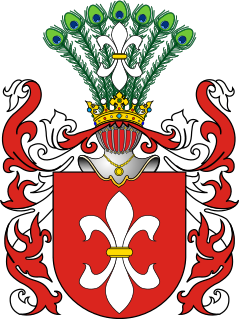
Piotrowski is a Polish surname derived from the masculine given name Piotr (Peter). The name, and its variations indicate a family's origin as being from a town, such as for instance Piotrów and Piotrowo, or a toponym deriving from a holding, manor or estate. Variants and related names include Piotrowicz, Piotrowiak, Piotrowsky, Pietrowski, Pietrkowski, Pietrowsky, and Pietrowiak.
The Tayichiud was one of the three core tribes of the Khamag Mongol confederation on the Mongolian Plateau during the 12th century.

The Mongolian nobility arose between the 10th and 12th centuries, became prominent in the 13th century, and essentially governed Mongolia until the early 20th century.

The Kharchin, or Kharachin, is a subgroup of the Mongols residing mainly in North-western Liaoning and Chifeng, Inner Mongolia. There are Khalkha-Kharchin Mongols in Dorno-Gobi Province and in Ulaanbaatar, Mongolia.

Genghis Khan was the founder and first Great Khan (Emperor) of the Mongol Empire, which became the largest contiguous empire in history after his death. He came to power by uniting many of the nomadic tribes of the Mongol steppe and being proclaimed the universal ruler of the Mongols, or Genghis Khan. With the tribes of Northeast Asia largely under his control, he set in motion the Mongol invasions, which ultimately witnessed the conquest of much of Eurasia, and incursions by Mongol raiding parties as far west as Legnica in western Poland and as far south as Gaza. He launched campaigns against the Qara Khitai, Khwarezmia, the Western Xia and Jin dynasty during his life, and his generals raided into medieval Georgia, Circassia, the Kievan Rus', and Volga Bulgaria.
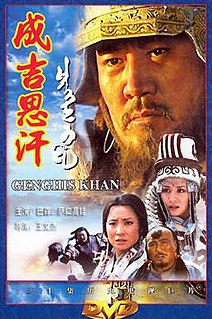
Genghis Khan is a Chinese television series based on the life of Genghis Khan, the founder of the Mongol Empire in the 13th century. Ba Sen, who portrayed the eponymous character in the series, is a descendant of Genghis Khan's second son, Chagatai. The series was first broadcast on CCTV in China in 2004, on KBS in South Korea in 2005, and the Turkish state channel TRT 1.
Stanisław Dziadulewicz: Herbarz rodów tatarskich w Polsce [Armorial of Tatar families in Poland]. Wilno 1929 (reprinted by WAiF. Warszawa 1986) [in Polish]














